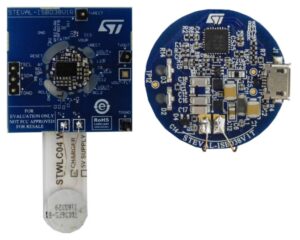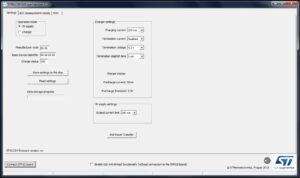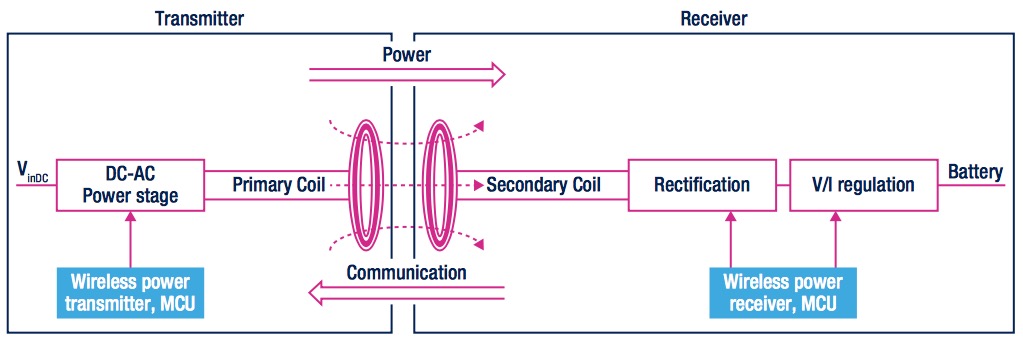From cars to cellphones, batteries are on everyone’s mind. Ironically, this component that was once overlooked can now make or break a design and a reputation. To complicate things, the increased popularity of wearable and IoT devices means engineers face a new set of challenges and restrictions. Batteries and their charging solutions must be smaller, more efficient, denser, without needing a charging port on the device that would cause the whole design to lose its water-resistant certification or become vulnerable to dust. To satisfy these new constraints, ST has released a wireless battery charger transmitter (STWBC-WA) and receiver (STWLC04) that offer very high efficiency with only a coil of only 1 cm diameter and some unique features. To more quickly and easily take advantage of this solution, ST also provides an evaluation board (STEVAL-ISB038V1) that contains these two components and tools to reduce development times.
Wireless charging, also known as inductive charging, is certainly not new since it is based on Faraday’s law of induction and Nikola Tesla first experimented with its principles in the 1890s. Very simply, chargers use a transmitter that draws current from a power source (wall socket, USB port, etc.) to send it to a coil to induce an electromagnetic field. Then, the receiver found in the device comes in close proximity so its coil can “pick up” the transmitter’s field. In other words, the receiver’s coil starts to resonate at the same frequency to generate an electrical current that will power the system or charge a battery.
Flexible Wireless Charging Receiver

Until recently, wireless charging technologies were inefficient and difficult to implement, often resulting in bulky devices that only worked with very specific sets of chargers. The STWLC04 1 W wireless charging receiver from ST changes all that. The chip only measures 3.12 mm x 4.73 mm, its step-down converter has a 90 % efficiency, and its compliance with the market standard means that it will work with the vast majority of transmitters already shipped.
One feature that separates the STWLC04 from the competition is the embedded 32-bit microcontroller that uses a 16 KB ROM and a 2 KB RAM, which is far more advanced than most receivers sold today. Not only does it allow greater control to ensure stable operations, but custom settings can be stored in memory. As a result, the STWLC04 can either be autonomous or controlled by a host, and it can either function as a voltage source with a regulated output of 5 V, or serve as a lithium-ion or lithium-polymer battery charger, offering engineers unparalleled flexibility.
Efficient Wireless Charging Transmitter
ST is also one of the few companies to have designed a transmitter that work alongside its receiver and extend the notion of design flexibility to the charger. As such, the STWBC-WA offers great scalability, meaning it can either be setup to support half-bridge topologies for up to 1 W power levels or use larger coils and full-bridge topologies for up to 3 W power levels. Furthermore, the presence of integrated drivers simplifies designs and reduces costs because no other external component has to be placed between the MOSFETs and the transmitter.
The STWBC-WA works with USB power supplies so engineers will be able to offer USB charging without needing to adjust or revise their designs. It is also able to monitor the power levels required by the receiver. As the device’s battery becomes full, the transmitter modulates the electromagnetic field to reduce waste and improve efficiency as well as operating temperatures.
Plug and Play

Finally, ST has packed both receiver and transmitter into a great development kit, the STEVAL-ISB038V1, that comes with a graphical interface to allow engineers to quickly configure their system as well as monitor behavior, which lowers the learning curve. ST also provides a guide that will facilitate the tuning process and documentation is available to quickly start development. Since there are no drivers to install, one can just plug the board to a Windows PC using the USB port and start experimenting.
Engineers will thus be able to test the different features and safety measures implemented. For instance, the Foreign Object Detection ensures that metallic objects do not accidentally trigger the transmitter or receiver, which could have damaging effects. There are also thermal protections in place to prevent the device from overheating.
You can find more information about ST’s battery chargers and power solutions by visiting its website.
